Deck 2: Knowing the Heavens
Question
Question
Question
Question
Question
Question
Question
Question
Question
Question
Question
Question
Question
Question
Question
Question
Question
Question
Question
Question
Question
Question
Question
Question
Question
Question
Question
Question
Question
Question
Question
Question
Question
Question
Question
Question
Question
Question
Question
Question
Question
Question
Question
Question
Question
Question
Question
Question
Question
Question
Question
Question
Question
Question
Question
Question
Question
Question
Question
Question
Question
Question
Question
Question
Question
Question
Question
Question
Question
Question
Question
Question
Question
Question
Question
Question
Question
Question
Question
Question

Unlock Deck
Sign up to unlock the cards in this deck!
Unlock Deck
Unlock Deck
1/99
Play
Full screen (f)
Deck 2: Knowing the Heavens
1
Which of the following was not obtained by people of ancient civilizations from observations of the night sky?
A)the relative distances of the Sun, the Moon, and stars from Earth
B)timing information, both daily and yearly
C)patterns of stars in the sky about which stories and myths were devised
D)directions for navigation
A)the relative distances of the Sun, the Moon, and stars from Earth
B)timing information, both daily and yearly
C)patterns of stars in the sky about which stories and myths were devised
D)directions for navigation
A
2
Two opposite sides of the Egyptian pyramids are aligned with which direction(s) on the horizon?
A)northeast to southwest
B)midsummer sunrise
C)north-south
D)rising of the star Sirius
A)northeast to southwest
B)midsummer sunrise
C)north-south
D)rising of the star Sirius
C
3
Meaningful observations of the sky by ancient peoples:
A)were, of necessity, restricted to the western hemisphere.
B)were, of necessity, restricted to the regions north of the equator.
C)were, of necessity, restricted to the regions south of the equator.
D)were made in regions throughout the world.
A)were, of necessity, restricted to the western hemisphere.
B)were, of necessity, restricted to the regions north of the equator.
C)were, of necessity, restricted to the regions south of the equator.
D)were made in regions throughout the world.
D
4
Which ancient culture discovered a 584-day pattern in the motions of Venus?
A)Native Americans in the southwestern United States
B)Mayan civilization in Central America
C)Stonehenge builders in England
D)Observers in ancient Egypt
A)Native Americans in the southwestern United States
B)Mayan civilization in Central America
C)Stonehenge builders in England
D)Observers in ancient Egypt

Unlock Deck
Unlock for access to all 99 flashcards in this deck.
Unlock Deck
k this deck
5
Constellations are generally made up of stars that are:
A)moving through space together.
B)about the same age.
C)separated by relatively small distances (compared to their distances from us).
D)merely located along more or less the same line of sight as viewed from Earth.
A)moving through space together.
B)about the same age.
C)separated by relatively small distances (compared to their distances from us).
D)merely located along more or less the same line of sight as viewed from Earth.

Unlock Deck
Unlock for access to all 99 flashcards in this deck.
Unlock Deck
k this deck
6
If a star is described as being in the constellation Leo, a modern astronomer knows that it is:
A)somewhere in a particular region of sky having definite boundaries.
B)in a distant galaxy located in a particular direction from Earth.
C)inside a region of the sky bounded by two lines of right ascension in the sky.
D)one of a few individual bright stars that make a picture (of a lion) in the sky.
A)somewhere in a particular region of sky having definite boundaries.
B)in a distant galaxy located in a particular direction from Earth.
C)inside a region of the sky bounded by two lines of right ascension in the sky.
D)one of a few individual bright stars that make a picture (of a lion) in the sky.

Unlock Deck
Unlock for access to all 99 flashcards in this deck.
Unlock Deck
k this deck
7
Diurnal motion of objects in the sky is caused by the:
A)precession of Earth's axis.
B)revolution of Earth around the Sun.
C)motion of the Moon across the sky.
D)rotation of Earth on its axis.
A)precession of Earth's axis.
B)revolution of Earth around the Sun.
C)motion of the Moon across the sky.
D)rotation of Earth on its axis.

Unlock Deck
Unlock for access to all 99 flashcards in this deck.
Unlock Deck
k this deck
8
With respect to the stars, the rotation of Earth carries you toward the:
A)south.
B)east.
C)west.
D)north.
A)south.
B)east.
C)west.
D)north.

Unlock Deck
Unlock for access to all 99 flashcards in this deck.
Unlock Deck
k this deck
9
If the stars Polaris and Arcturus (as shown in Figure 2-6 of Universe, 11th ed.), are known to be 71° apart, how far away from Polaris is the closest star in Ursa Major?
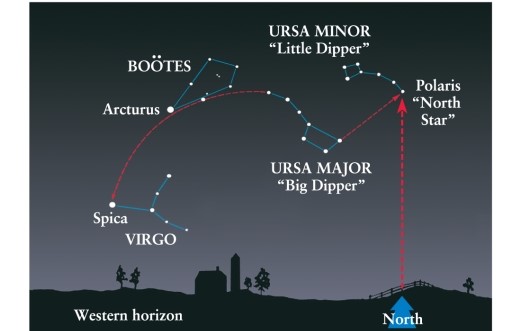
A)about 25°
B)about 2.5°
C)about 250°
D)about 7.1°

A)about 25°
B)about 2.5°
C)about 250°
D)about 7.1°

Unlock Deck
Unlock for access to all 99 flashcards in this deck.
Unlock Deck
k this deck
10
If the stars Polaris and Spica are 101° apart (as shown in Figure 2-6 of Universe, 11th ed.), how far away from Polaris is the closest star in Ursa Major, from our view?
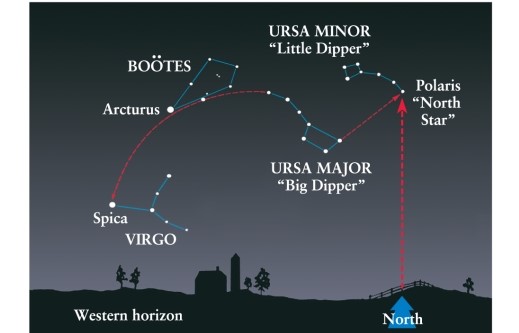
A)about 2.5°
B)about 260°
C)about 77°
D)about 25°

A)about 2.5°
B)about 260°
C)about 77°
D)about 25°

Unlock Deck
Unlock for access to all 99 flashcards in this deck.
Unlock Deck
k this deck
11
In late September, Andromeda appears high in the sky at midnight. Six months later Virgo appears high in the sky at midnight. Where is Andromeda at this time?
A)It is still high in the sky at midnight.
B)It has moved to the western horizon.
C)It has moved to the eastern horizon.
D)It is high in the sky at noon and is thus not visible.
A)It is still high in the sky at midnight.
B)It has moved to the western horizon.
C)It has moved to the eastern horizon.
D)It is high in the sky at noon and is thus not visible.

Unlock Deck
Unlock for access to all 99 flashcards in this deck.
Unlock Deck
k this deck
12
Perseus appears high in the sky at midnight in November. Andromeda appears high in the sky at midnight in September. (See Figure 2-5 of Universe, 11th ed.) Where is Andromeda at midnight in November?
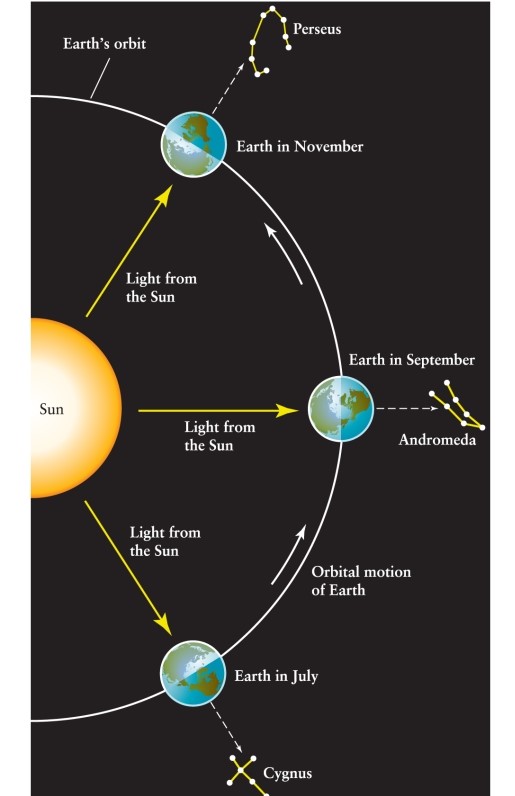
A)It remains high in the center of the sky.
B)It will be near the eastern horizon.
C)It will be near the western horizon.
D)It will be high in the sky at noon and thus will not be visible.

A)It remains high in the center of the sky.
B)It will be near the eastern horizon.
C)It will be near the western horizon.
D)It will be high in the sky at noon and thus will not be visible.

Unlock Deck
Unlock for access to all 99 flashcards in this deck.
Unlock Deck
k this deck
13
Cygnus appears high in the sky at midnight in July. Andromeda appears high in the sky at midnight in September. (See Figure 2-5 of Universe, 11th ed.) Where is Andromeda at midnight in July?
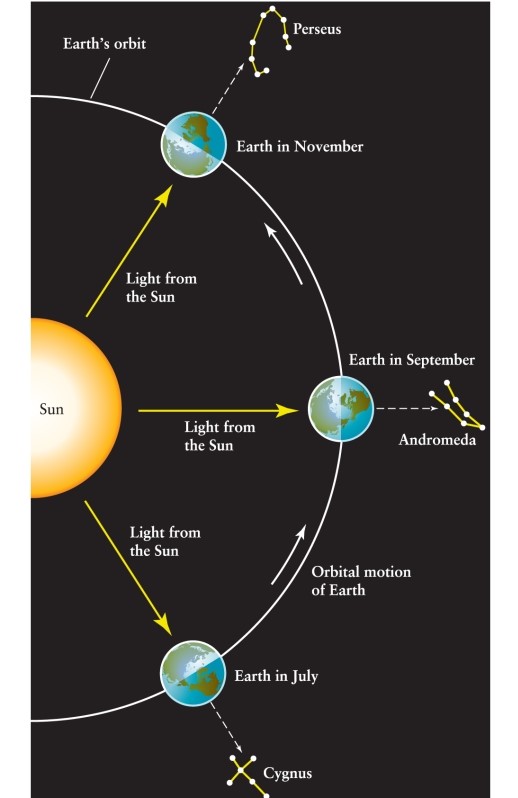
A)It is still high in the sky at midnight.
B)It has moved to the western horizon.
C)It has moved to the eastern horizon.
D)It is high in the sky at noon and is thus not visible.

A)It is still high in the sky at midnight.
B)It has moved to the western horizon.
C)It has moved to the eastern horizon.
D)It is high in the sky at noon and is thus not visible.

Unlock Deck
Unlock for access to all 99 flashcards in this deck.
Unlock Deck
k this deck
14
Sirius is the brightest star in the night sky. You watch it set behind the western horizon about 2 A.M. in the middle of February. About what time will it set in the middle of March?
A) 10 P.M.
B) midnight
C) 2 A.M.
D) 4 A.M.
A) 10 P.M.
B) midnight
C) 2 A.M.
D) 4 A.M.

Unlock Deck
Unlock for access to all 99 flashcards in this deck.
Unlock Deck
k this deck
15
People in which one of the following cities experience sunrise first?
A)New York
B)San Francisco
C)Chicago
D)Denver
A)New York
B)San Francisco
C)Chicago
D)Denver

Unlock Deck
Unlock for access to all 99 flashcards in this deck.
Unlock Deck
k this deck
16
How much of the overall sky is north of the celestial equator, that is, in the northern hemisphere?
A)all of it, by definition
B)exactly one-half
C)less than one-half, because of the tilt of the equator to the ecliptic plane
D)more than one-half, because of the precession of the poles
A)all of it, by definition
B)exactly one-half
C)less than one-half, because of the tilt of the equator to the ecliptic plane
D)more than one-half, because of the precession of the poles

Unlock Deck
Unlock for access to all 99 flashcards in this deck.
Unlock Deck
k this deck
17
Compared with its appearance to a person in mid-latitude northern latitudes, how will the constellation Orion appear to an observer in Australia?
A)exactly the same since the stars of Orion are very far away from Earth
B)upside down but with the same orientation of stars
C)upside down and inverted left to right, a mirror image of that seen in the northern hemisphere
D)same way up but inverted left to right
A)exactly the same since the stars of Orion are very far away from Earth
B)upside down but with the same orientation of stars
C)upside down and inverted left to right, a mirror image of that seen in the northern hemisphere
D)same way up but inverted left to right

Unlock Deck
Unlock for access to all 99 flashcards in this deck.
Unlock Deck
k this deck
18
If you are standing on Earth's equator, your zenith (the vertical direction above your head) over a period of 1 year will maintain which of the following alignments?
A)a fixed angle of 23.5° to the spin axis of Earth
B)an angle to Earth's spin axis that will vary between 0° and 23.5° over a period of 6 months
C)parallel to Earth's spin axis
D)perpendicular to Earth's spin axis
A)a fixed angle of 23.5° to the spin axis of Earth
B)an angle to Earth's spin axis that will vary between 0° and 23.5° over a period of 6 months
C)parallel to Earth's spin axis
D)perpendicular to Earth's spin axis

Unlock Deck
Unlock for access to all 99 flashcards in this deck.
Unlock Deck
k this deck
19
If you view the sky from 20° north of the equator, the north circumpolar stars (which do not rise and set) would be:
A)the stars within 20° of the horizon.
B)the stars within 20° of Polaris, the North Star.
C)the stars within 20° of the zenith (the point directly overhead).
D)nonexistent, since all the stars rise and set when viewed from 20° north of the equator.
A)the stars within 20° of the horizon.
B)the stars within 20° of Polaris, the North Star.
C)the stars within 20° of the zenith (the point directly overhead).
D)nonexistent, since all the stars rise and set when viewed from 20° north of the equator.

Unlock Deck
Unlock for access to all 99 flashcards in this deck.
Unlock Deck
k this deck
20
A given star in the sky will reach its highest point to a particular observer in the northern hemisphere when it passes through the:
A)celestial equator.
B)zodiac.
C)ecliptic plane.
D)region of the sky due south.
A)celestial equator.
B)zodiac.
C)ecliptic plane.
D)region of the sky due south.

Unlock Deck
Unlock for access to all 99 flashcards in this deck.
Unlock Deck
k this deck
21
As Earth rotates, the apparent motion of the pole star, Polaris, in a period of a day is:
A)a slow drift across the sky.
B)a wobble back and forth in a straight line.
C)a small circle with a radius of less than 1° in about 24 hours.
D)zero; there is no motion of the pole star by definition.
A)a slow drift across the sky.
B)a wobble back and forth in a straight line.
C)a small circle with a radius of less than 1° in about 24 hours.
D)zero; there is no motion of the pole star by definition.

Unlock Deck
Unlock for access to all 99 flashcards in this deck.
Unlock Deck
k this deck
22
To navigators in the northern hemisphere, their latitude in degrees is equal to:
A)15 times the number of hours since the sun set.
B)the angle between their meridian and the north celestial pole.
C)the angle between the north celestial pole and their zenith.
D)the angle between the north celestial pole and their northern horizon.
A)15 times the number of hours since the sun set.
B)the angle between their meridian and the north celestial pole.
C)the angle between the north celestial pole and their zenith.
D)the angle between the north celestial pole and their northern horizon.

Unlock Deck
Unlock for access to all 99 flashcards in this deck.
Unlock Deck
k this deck
23
At a certain time the star straight overhead has a right ascension of 2 hours and 30 minutes. One hour later this same star will have a right ascension of:
A)1 hour and 30 minutes.
B)2 hours and 30 minutes.
C)3 hours and 30 minutes.
D)4 hours and 30 minutes.
A)1 hour and 30 minutes.
B)2 hours and 30 minutes.
C)3 hours and 30 minutes.
D)4 hours and 30 minutes.

Unlock Deck
Unlock for access to all 99 flashcards in this deck.
Unlock Deck
k this deck
24
Over what range of declination will stars be circumpolar (i.e., be visible at any time of the night on any night of the year) for an observer at 30° north latitude?
A)60° to 90°N and 60° to 90°S
B)60° to 90°N
C)30° to 90°N
D)0° to 30°N
A)60° to 90°N and 60° to 90°S
B)60° to 90°N
C)30° to 90°N
D)0° to 30°N

Unlock Deck
Unlock for access to all 99 flashcards in this deck.
Unlock Deck
k this deck
25
Over what range of declination will stars be circumpolar (i.e., be visible at any time of the night on any night of the year) for an observer at the South Pole?
A)0° to 90°N
B)only stars at the south celestial pole
C)90°S to 90°N (the whole sky)
D)0° to 90°S
A)0° to 90°N
B)only stars at the south celestial pole
C)90°S to 90°N (the whole sky)
D)0° to 90°S

Unlock Deck
Unlock for access to all 99 flashcards in this deck.
Unlock Deck
k this deck
26
The two angles used by astronomers to define the position of a star in the sky and define a coordinate system applicable anywhere on Earth are:
A)azimuth and elevation.
B)latitude and longitude.
C)horizontal and vertical angles.
D)right ascension and declination.
A)azimuth and elevation.
B)latitude and longitude.
C)horizontal and vertical angles.
D)right ascension and declination.

Unlock Deck
Unlock for access to all 99 flashcards in this deck.
Unlock Deck
k this deck
27
The declination angle between the north celestial pole and the celestial equator is:
A)360°.
B)89° because of the displacement of the Pole Star.
C)180°.
D)90°.
A)360°.
B)89° because of the displacement of the Pole Star.
C)180°.
D)90°.

Unlock Deck
Unlock for access to all 99 flashcards in this deck.
Unlock Deck
k this deck
28
The declination of a star is a measure of its:
A)position above the observer's horizon along a great circle passing through the observer's zenith.
B)time of rising above the horizon.
C)position along the celestial equator.
D)position north or south of the celestial equator along a great circle passing through the north and south celestial poles.
A)position above the observer's horizon along a great circle passing through the observer's zenith.
B)time of rising above the horizon.
C)position along the celestial equator.
D)position north or south of the celestial equator along a great circle passing through the north and south celestial poles.

Unlock Deck
Unlock for access to all 99 flashcards in this deck.
Unlock Deck
k this deck
29
In the right ascension coordinate direction, 1 hour corresponds to what equivalent angle?
A)15°
B)360°
C)1°
D)variable depending on the time of year
A)15°
B)360°
C)1°
D)variable depending on the time of year

Unlock Deck
Unlock for access to all 99 flashcards in this deck.
Unlock Deck
k this deck
30
What is the angle, measured in degrees between two stars of RA = 4h, declination = 0°, and RA = 8h, declination = 0°?
A)4°
B)0°, since declinations are equal
C)120°
D)60°
A)4°
B)0°, since declinations are equal
C)120°
D)60°

Unlock Deck
Unlock for access to all 99 flashcards in this deck.
Unlock Deck
k this deck
31
The summer solstice position coordinates are RA = 6h 0m 0s, declination = +23° 27´. What are the coordinates of the winter solstice?
A)RA = 18h 0m 0s, declination = +23° 27´
B)RA = 0h 0m 0s, declination = 0° 0', by definition
C)RA = 12h 0m 0s, declination = -23° 27´
D)RA = 18h 0m 0s, declination = -23° 27´
A)RA = 18h 0m 0s, declination = +23° 27´
B)RA = 0h 0m 0s, declination = 0° 0', by definition
C)RA = 12h 0m 0s, declination = -23° 27´
D)RA = 18h 0m 0s, declination = -23° 27´

Unlock Deck
Unlock for access to all 99 flashcards in this deck.
Unlock Deck
k this deck
32
A star with RA = 4h is in your meridian at a certain time. Which of the following stars will be on your meridian 2.5 hours from now?
A)RA = 6h 30m
B)RA = 4h 2m 30s
C)RA = 1h 30m
D)RA = 4h, since RA of a star does not change with time
A)RA = 6h 30m
B)RA = 4h 2m 30s
C)RA = 1h 30m
D)RA = 4h, since RA of a star does not change with time

Unlock Deck
Unlock for access to all 99 flashcards in this deck.
Unlock Deck
k this deck
33
At what approximate value of declination was the Sun on September 21 this year?
A)23.5°
B)90°
C)180°
D)0°
A)23.5°
B)90°
C)180°
D)0°

Unlock Deck
Unlock for access to all 99 flashcards in this deck.
Unlock Deck
k this deck
34
At what approximate value of declination was the Sun on December 21 this year?
A)23.5°
B)90°
C)0°
D)-23.5°
A)23.5°
B)90°
C)0°
D)-23.5°

Unlock Deck
Unlock for access to all 99 flashcards in this deck.
Unlock Deck
k this deck
35
At what approximate value of right ascension was the Sun this year on March 21?
A)1 hour
B)no particular value
C)12 hours
D)0 hours
A)1 hour
B)no particular value
C)12 hours
D)0 hours

Unlock Deck
Unlock for access to all 99 flashcards in this deck.
Unlock Deck
k this deck
36
At what approximate value of right ascension was the Sun this year on June 21?
A)18 hours
B)0 hours
C)12 hours
D)6 hours
A)18 hours
B)0 hours
C)12 hours
D)6 hours

Unlock Deck
Unlock for access to all 99 flashcards in this deck.
Unlock Deck
k this deck
37
At what approximate value of right ascension was the Sun this year on September 21?
A)18 hours
B)0 hours
C)6 hours
D)12 hours
A)18 hours
B)0 hours
C)6 hours
D)12 hours

Unlock Deck
Unlock for access to all 99 flashcards in this deck.
Unlock Deck
k this deck
38
At what approximate value of right ascension was the Sun this year on December 21?
A)0 hours
B)12 hours
C)18 hours
D)6 hours
A)0 hours
B)12 hours
C)18 hours
D)6 hours

Unlock Deck
Unlock for access to all 99 flashcards in this deck.
Unlock Deck
k this deck
39
The celestial coordinates of the star ß Tauri are right ascension 5h 25m, declination +28°, and those of the star ß Geminorum are right ascension 7h 44m, declination +28°. Measured along the shortest angle in the sky between the two stars, ß Tauri is:
A)west of ß Geminorum.
B)south of ß Geminorum.
C)north of ß Geminorum.
D)east of ß Geminorum.
A)west of ß Geminorum.
B)south of ß Geminorum.
C)north of ß Geminorum.
D)east of ß Geminorum.

Unlock Deck
Unlock for access to all 99 flashcards in this deck.
Unlock Deck
k this deck
40
The celestial coordinates of the star γ Geminorum are right ascension 6h 37m, declination +16°; the coordinates of the star α Tauri are right ascension 4h 35m, declination +16°. Measured along the shortest angle in the sky between the two stars, γ Geminorum is:
A)north of α Tauri.
B)east of α Tauri.
C)south of α Tauri.
D)west of α Tauri.
A)north of α Tauri.
B)east of α Tauri.
C)south of α Tauri.
D)west of α Tauri.

Unlock Deck
Unlock for access to all 99 flashcards in this deck.
Unlock Deck
k this deck
41
The celestial coordinates of the star γ Persei are right ascension 3h 03m, declination +53°; the coordinates of the star ρ Persei are right ascension 3h 03m, declination +39°. Measured along the shortest angle in the sky between the two stars, γ Persei is:
A)west of ρ Persei.
B)north of ρ Persei.
C)south of ρ Persei.
D)east of ρ Persei.
A)west of ρ Persei.
B)north of ρ Persei.
C)south of ρ Persei.
D)east of ρ Persei.

Unlock Deck
Unlock for access to all 99 flashcards in this deck.
Unlock Deck
k this deck
42
The celestial coordinates of the star ζ Leonis are right ascension 10h 16m, declination +24°; the coordinates of the star λ Ursae Majoris are right ascension 10h 16m, declination +43°. Measured along the shortest angle in the sky between the two stars, ζ Leonis is:
A)west of λ Ursae Majoris.
B)north of λ Ursae Majoris.
C)east of λ Ursae Majoris.
D)south of λ Ursae Majoris.
A)west of λ Ursae Majoris.
B)north of λ Ursae Majoris.
C)east of λ Ursae Majoris.
D)south of λ Ursae Majoris.

Unlock Deck
Unlock for access to all 99 flashcards in this deck.
Unlock Deck
k this deck
43
The two bright stars in the constellation Gemini, the Twins are Castor (right ascension 7h 33m, declination +31° 56N) and Pollux (right ascension 7h 44m, declination +28° 5N). From these coordinates you can see that:
A)Pollux is slightly southeast of Castor.
B)Pollux is slightly northwest of Castor.
C)Pollux is slightly northeast of Castor.
D)Pollux is slightly southwest of Castor.
A)Pollux is slightly southeast of Castor.
B)Pollux is slightly northwest of Castor.
C)Pollux is slightly northeast of Castor.
D)Pollux is slightly southwest of Castor.

Unlock Deck
Unlock for access to all 99 flashcards in this deck.
Unlock Deck
k this deck
44
You are looking at the star Aldebaran (right ascension 4h 34m, declination +16° 28N) from a location in the northern hemisphere. Where is the star Betelgeuse (right ascension 5h 54m, declination +7° 24N)?
A)below Aldebaran and to the left
B)above Aldebaran and to the left
C)below Aldebaran and to the right
D)above Aldebaran and to the right
A)below Aldebaran and to the left
B)above Aldebaran and to the left
C)below Aldebaran and to the right
D)above Aldebaran and to the right

Unlock Deck
Unlock for access to all 99 flashcards in this deck.
Unlock Deck
k this deck
45
The declination of Polaris, the North Star, when viewed from a location 35° north of the equator, is:
A)0°.
B)35°.
C)55°.
D)90°.
A)0°.
B)35°.
C)55°.
D)90°.

Unlock Deck
Unlock for access to all 99 flashcards in this deck.
Unlock Deck
k this deck
46
Where must you stand on Earth to have the celestial equator along your horizon?
A)the North Pole
B)the South Pole
C)either pole
D)the equator
A)the North Pole
B)the South Pole
C)either pole
D)the equator

Unlock Deck
Unlock for access to all 99 flashcards in this deck.
Unlock Deck
k this deck
47
Where must you stand on Earth to have the celestial equator pass through your zenith?
A)the North Pole
B)the South Pole
C)either pole
D)the equator
A)the North Pole
B)the South Pole
C)either pole
D)the equator

Unlock Deck
Unlock for access to all 99 flashcards in this deck.
Unlock Deck
k this deck
48
If we could observe background stars in daylight, how would the Sun appear to move against this background because of our motion on an orbiting Earth?
A)1° per day, from west to east
B)15° per hour, from east to west
C)1° per day, from east to west
D)15° per hour, from west to east
A)1° per day, from west to east
B)15° per hour, from east to west
C)1° per day, from east to west
D)15° per hour, from west to east

Unlock Deck
Unlock for access to all 99 flashcards in this deck.
Unlock Deck
k this deck
49
If the daytime sky were not bright, in which direction would we see the Sun move along the ecliptic over the course of 1 year, relative to the background stars?
A)toward the east
B)toward the southwest
C)toward the west
D)toward the northwest
A)toward the east
B)toward the southwest
C)toward the west
D)toward the northwest

Unlock Deck
Unlock for access to all 99 flashcards in this deck.
Unlock Deck
k this deck
50
What is the primary cause of Earth's seasons?
A)The orbit of Earth is an ellipse, so Earth is not always the same distance from the Sun.
B)Earth's rotation axis tilts with respect to the plane of its orbit around the Sun.
C)Earth's precession axis precesses (wobbles).
D)In accord with Kepler's second law, Earth moves faster during parts of its orbit around the Sun and more slowly during other parts.
A)The orbit of Earth is an ellipse, so Earth is not always the same distance from the Sun.
B)Earth's rotation axis tilts with respect to the plane of its orbit around the Sun.
C)Earth's precession axis precesses (wobbles).
D)In accord with Kepler's second law, Earth moves faster during parts of its orbit around the Sun and more slowly during other parts.

Unlock Deck
Unlock for access to all 99 flashcards in this deck.
Unlock Deck
k this deck
51
If Earth's spin axis were perpendicular to Earth's orbital plane (the ecliptic plane), then the seasons and seasonal variation would be:
A)very little different from the present seasons.
B)much faster (shorter seasons), but less severe.
C)much more severe.
D)nonexistent.
A)very little different from the present seasons.
B)much faster (shorter seasons), but less severe.
C)much more severe.
D)nonexistent.

Unlock Deck
Unlock for access to all 99 flashcards in this deck.
Unlock Deck
k this deck
52
The tilt of Earth's spin axis to the direction perpendicular to the ecliptic plane (known as the ecliptic pole) is:
A)variable between 0° and 23.5° over each 3-month season.
B)0°.
C)23.5°.
D)90°.
A)variable between 0° and 23.5° over each 3-month season.
B)0°.
C)23.5°.
D)90°.

Unlock Deck
Unlock for access to all 99 flashcards in this deck.
Unlock Deck
k this deck
53
At which time of the year will your shadow in sunlight at midday be shortest?
A)midwinter, or early January
B)midsummer, about August 5
C)the first day of summer, about June 21
D)the first day of spring, about March 21
A)midwinter, or early January
B)midsummer, about August 5
C)the first day of summer, about June 21
D)the first day of spring, about March 21

Unlock Deck
Unlock for access to all 99 flashcards in this deck.
Unlock Deck
k this deck
54
Seasonal variations on a planet's surface occur because:
A)the planet's distance from the Sun varies periodically over the orbital path.
B)clouds alternately form and decay away in a periodic way.
C)the planet's axis of spin is tilted with respect to the perpendicular to the orbital plane.
D)volcanoes periodically cloud out the atmospheres of planets because of tidal interactions and distortions.
A)the planet's distance from the Sun varies periodically over the orbital path.
B)clouds alternately form and decay away in a periodic way.
C)the planet's axis of spin is tilted with respect to the perpendicular to the orbital plane.
D)volcanoes periodically cloud out the atmospheres of planets because of tidal interactions and distortions.

Unlock Deck
Unlock for access to all 99 flashcards in this deck.
Unlock Deck
k this deck
55
What does it mean to be "in the tropics," that is, between the Tropic of Cancer and the Tropic of Capricorn?
A)The Sun is directly overhead at noon every day.
B)The Sun is directly overhead on at least 1 day of the year.
C)The stars do not appear to rise and set.
D)Days and nights are of equal length all year long.
A)The Sun is directly overhead at noon every day.
B)The Sun is directly overhead on at least 1 day of the year.
C)The stars do not appear to rise and set.
D)Days and nights are of equal length all year long.

Unlock Deck
Unlock for access to all 99 flashcards in this deck.
Unlock Deck
k this deck
56
The time of autumnal equinox, about September 21, is what season for Australians in the southern hemisphere?
A)beginning of spring
B)middle of winter
C)middle of summer
D)beginning of autumn or fall
A)beginning of spring
B)middle of winter
C)middle of summer
D)beginning of autumn or fall

Unlock Deck
Unlock for access to all 99 flashcards in this deck.
Unlock Deck
k this deck
57
In winter in the southern hemisphere, the Sun will rise on the:
A)northwestern horizon.
B)northeastern horizon.
C)southwestern horizon.
D)southeastern horizon.
A)northwestern horizon.
B)northeastern horizon.
C)southwestern horizon.
D)southeastern horizon.

Unlock Deck
Unlock for access to all 99 flashcards in this deck.
Unlock Deck
k this deck
58
The Arctic Circle is at a latitude of:
A)66.5°N.
B)66.5°S.
C)23.5°N.
D)a variable average of 66.5°.
A)66.5°N.
B)66.5°S.
C)23.5°N.
D)a variable average of 66.5°.

Unlock Deck
Unlock for access to all 99 flashcards in this deck.
Unlock Deck
k this deck
59
If you were standing on the equator, which of the following positions in the sky would pass directly over your head (i.e., through your zenith) at some time in one 24-hour period? (See Figure 2-15 of Universe, 11th ed.)
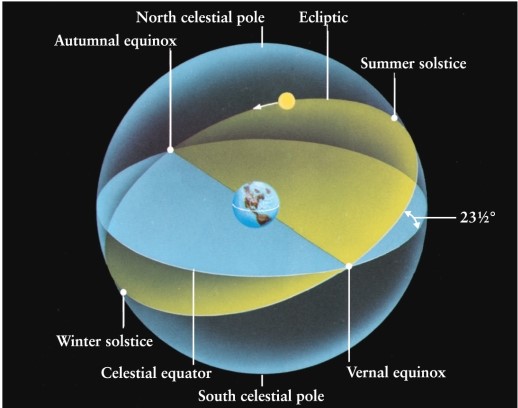
A)the position of the Sun at summer solstice
B)the ecliptic pole, or perpendicular to the direction of the ecliptic plane
C)the vernal equinox, or the zero point of the right ascension on the celestial equator
D)the north celestial pole, or perpendicular to the direction of the celestial equator

A)the position of the Sun at summer solstice
B)the ecliptic pole, or perpendicular to the direction of the ecliptic plane
C)the vernal equinox, or the zero point of the right ascension on the celestial equator
D)the north celestial pole, or perpendicular to the direction of the celestial equator

Unlock Deck
Unlock for access to all 99 flashcards in this deck.
Unlock Deck
k this deck
60
If the Sun passes through your zenith sometime during the year, then you must be:
A)anywhere within 23.5° of the equator.
B)anywhere within 66.5° of the equator.
C)exactly on the equator.
D)anywhere on Earth (no limitation).
A)anywhere within 23.5° of the equator.
B)anywhere within 66.5° of the equator.
C)exactly on the equator.
D)anywhere on Earth (no limitation).

Unlock Deck
Unlock for access to all 99 flashcards in this deck.
Unlock Deck
k this deck
61
During one complete year, an observer on the equator would be able to see what fraction of the overall sky?
A)50%
B)a variable amount, depending on the person's longitude
C)a variable amount, depending on which year
D)100%
A)50%
B)a variable amount, depending on the person's longitude
C)a variable amount, depending on which year
D)100%

Unlock Deck
Unlock for access to all 99 flashcards in this deck.
Unlock Deck
k this deck
62
Where would you have to be in order to see the north celestial pole in your zenith?
A)about 1° away from the South Pole, to account for precession
B)North Pole
C)South Pole
D)equator
A)about 1° away from the South Pole, to account for precession
B)North Pole
C)South Pole
D)equator

Unlock Deck
Unlock for access to all 99 flashcards in this deck.
Unlock Deck
k this deck
63
You view the night sky for a period of 1 hour. What changes during this hour?
A)the right ascension of a particular star, like Castor in Gemini
B)the declination of a particular star, like Pollux in Gemini
C)the right ascension of the star at your zenith
D)the position of Polaris
A)the right ascension of a particular star, like Castor in Gemini
B)the declination of a particular star, like Pollux in Gemini
C)the right ascension of the star at your zenith
D)the position of Polaris

Unlock Deck
Unlock for access to all 99 flashcards in this deck.
Unlock Deck
k this deck
64
Suppose Earth's rotation axis were straight up and down with respect to the plane of the ecliptic and not tilted. How would a person exactly at the north pole view the Sun?
A)The Sun would always be below the horizon and never visible.
B)The Sun would always be visible on the horizon.
C)The Sun would be visible for half the year, as is the case now.
D)The Sun would be visible for more than half the year, but not for the whole year.
A)The Sun would always be below the horizon and never visible.
B)The Sun would always be visible on the horizon.
C)The Sun would be visible for half the year, as is the case now.
D)The Sun would be visible for more than half the year, but not for the whole year.

Unlock Deck
Unlock for access to all 99 flashcards in this deck.
Unlock Deck
k this deck
65
Suppose Earth's rotation axis were straight up and down with respect to the plane of the ecliptic and not tilted. Each of the following statements would be true except one. Which one would not be true?
A)The stars would rise along paths perpendicular to the horizon (rather than slanted) when viewed from middle latitudes.
B)Seasons, as we presently experience them, would not exist.
C)Every point on Earth would experience 12 hours of sunlight and 12 hours of darkness each day.
D)In general, the declinations of stars would be different from their present values.
A)The stars would rise along paths perpendicular to the horizon (rather than slanted) when viewed from middle latitudes.
B)Seasons, as we presently experience them, would not exist.
C)Every point on Earth would experience 12 hours of sunlight and 12 hours of darkness each day.
D)In general, the declinations of stars would be different from their present values.

Unlock Deck
Unlock for access to all 99 flashcards in this deck.
Unlock Deck
k this deck
66
What is the definition of the vernal equinox?
A)March 21
B)the point on the celestial equator crossed by the local meridian at Greenwich Observatory
C)the date when the Sun first enters the constellation Aries
D)the point on the ecliptic where the Sun crosses the celestial equator from south to north
A)March 21
B)the point on the celestial equator crossed by the local meridian at Greenwich Observatory
C)the date when the Sun first enters the constellation Aries
D)the point on the ecliptic where the Sun crosses the celestial equator from south to north

Unlock Deck
Unlock for access to all 99 flashcards in this deck.
Unlock Deck
k this deck
67
What is the right ascension of the Sun?
A)0 hours
B)12 hours
C)a number that changes only very slowly because of precession
D)a number that changes significantly over a day
A)0 hours
B)12 hours
C)a number that changes only very slowly because of precession
D)a number that changes significantly over a day

Unlock Deck
Unlock for access to all 99 flashcards in this deck.
Unlock Deck
k this deck
68
What is the declination of the Sun?
A)0°
B)90°
C)a number that changes only very slowly because of precession
D)a number that changes significantly over a day
A)0°
B)90°
C)a number that changes only very slowly because of precession
D)a number that changes significantly over a day

Unlock Deck
Unlock for access to all 99 flashcards in this deck.
Unlock Deck
k this deck
69
What is the declination of Polaris?
A)0°
B)90°
C)a number that depends on the latitude from which you are observing
D)a number that changes significantly over a day
A)0°
B)90°
C)a number that depends on the latitude from which you are observing
D)a number that changes significantly over a day

Unlock Deck
Unlock for access to all 99 flashcards in this deck.
Unlock Deck
k this deck
70
In its motion across the sky against the background stars in the course of a month, the Moon appears to move about:
A)0.5° per day, its own diameter, from west to east.
B)1.0° per day, twice its diameter, from west to east.
C)0.5° per hour, its own diameter, from east to west.
D)0.5° per hour, its own diameter, from west to east.
A)0.5° per day, its own diameter, from west to east.
B)1.0° per day, twice its diameter, from west to east.
C)0.5° per hour, its own diameter, from east to west.
D)0.5° per hour, its own diameter, from west to east.

Unlock Deck
Unlock for access to all 99 flashcards in this deck.
Unlock Deck
k this deck
71
The zodiac is a:
A)band of sky extending 8° on each side of the celestial equator.
B)constellation representing a boat in the sky.
C)band of sky extending 8° on either side of the ecliptic.
D)band of sky 8° wide centered on the ecliptic.
A)band of sky extending 8° on each side of the celestial equator.
B)constellation representing a boat in the sky.
C)band of sky extending 8° on either side of the ecliptic.
D)band of sky 8° wide centered on the ecliptic.

Unlock Deck
Unlock for access to all 99 flashcards in this deck.
Unlock Deck
k this deck
72
The total width of the zodiac surrounding the ecliptic plane in the sky is approximately:
A)8°.
B)16°.
C)23.5°.
D)1°.
A)8°.
B)16°.
C)23.5°.
D)1°.

Unlock Deck
Unlock for access to all 99 flashcards in this deck.
Unlock Deck
k this deck
73
What is the significance of Polaris, the North Star?
A)It has been chosen as the zero point for declination measurements because it will always be at the pole of Earth's axis, i.e., due north.
B)The direction from Earth to Polaris is used as the zero line of prime meridian for measurements of right ascension.
C)Polaris is near the center of the curve traced out by the rotation axis as a result of the precession of the rotation direction.
D)Polaris is almost on the curve traced out by the rotation axis as a result of the precession of the rotation direction.
A)It has been chosen as the zero point for declination measurements because it will always be at the pole of Earth's axis, i.e., due north.
B)The direction from Earth to Polaris is used as the zero line of prime meridian for measurements of right ascension.
C)Polaris is near the center of the curve traced out by the rotation axis as a result of the precession of the rotation direction.
D)Polaris is almost on the curve traced out by the rotation axis as a result of the precession of the rotation direction.

Unlock Deck
Unlock for access to all 99 flashcards in this deck.
Unlock Deck
k this deck
74
Polaris is our "pole star" at the present time. At approximately what time in history or in the future would the star Thuban be our "pole star?" (See Figure 2-20 of Universe, 11th ed.)
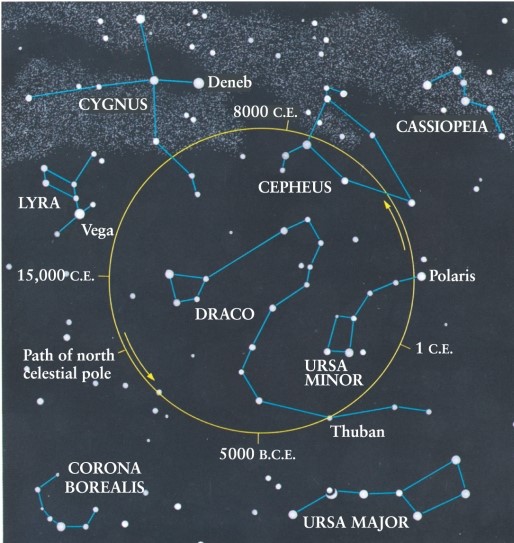
A) never, since Polaris will always be our "pole star" when viewed from Earth
B) 1 C.E.
C) 3000 C.E.
D) 3000 B.C.E.

A) never, since Polaris will always be our "pole star" when viewed from Earth
B) 1 C.E.
C) 3000 C.E.
D) 3000 B.C.E.

Unlock Deck
Unlock for access to all 99 flashcards in this deck.
Unlock Deck
k this deck
75
Precession of Earth's axis of rotation is caused by:
A)changes in the rate of rotation (length of the day) of Earth caused primarily by the gravitational pull of the Moon.
B)changes in the shape of Earth's orbit due to the gravitational pull of the Moon.
C)the gravitational pull of the Moon and the Sun on the equatorial bulge of Earth.
D)changes in the shape of Earth's orbit due to the gravitational pull of the Sun.
A)changes in the rate of rotation (length of the day) of Earth caused primarily by the gravitational pull of the Moon.
B)changes in the shape of Earth's orbit due to the gravitational pull of the Moon.
C)the gravitational pull of the Moon and the Sun on the equatorial bulge of Earth.
D)changes in the shape of Earth's orbit due to the gravitational pull of the Sun.

Unlock Deck
Unlock for access to all 99 flashcards in this deck.
Unlock Deck
k this deck
76
If the polar axis of Earth precesses through a full circle (See Figure 2-20 of Universe, 11th ed.) in 26,000 years, how many years will it take for the line between the axis and the center of the circle to move through 1°?
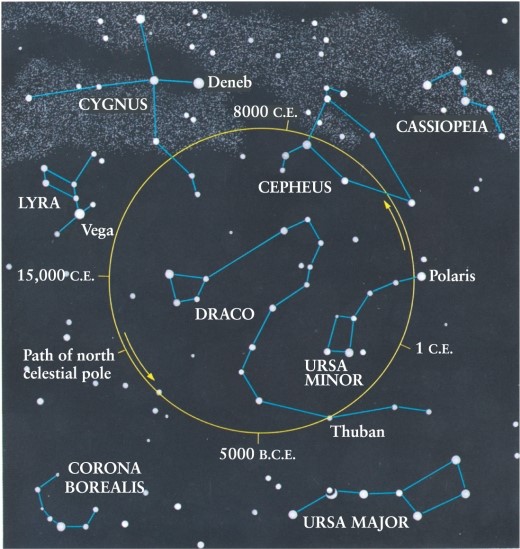
A)720
B)0.014
C)7.2
D)72

A)720
B)0.014
C)7.2
D)72

Unlock Deck
Unlock for access to all 99 flashcards in this deck.
Unlock Deck
k this deck
77
To what constellation will the north celestial pole be closest in the year 14,000 C.E.? (See Figure 2-20 of Universe, 11th ed.) 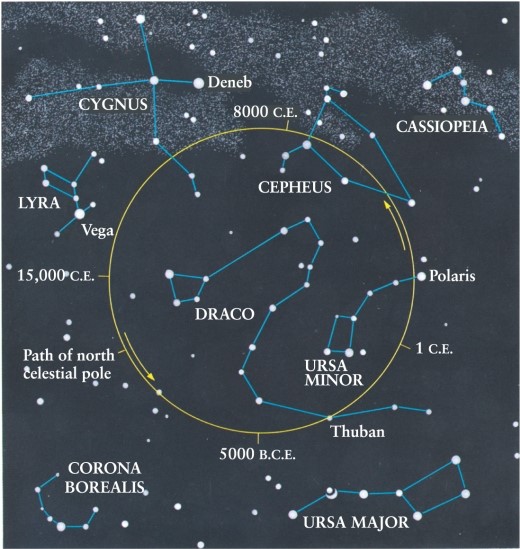
A)Draco
B)Lyra
C)Cepheus
D)Ursa Major, since the north celestial pole never moves

A)Draco
B)Lyra
C)Cepheus
D)Ursa Major, since the north celestial pole never moves

Unlock Deck
Unlock for access to all 99 flashcards in this deck.
Unlock Deck
k this deck
78
Do the astronomical coordinates of right ascension and declination of a star change systematically night by night?
A)They do not change, since they are positions on a fixed star chart.
B)Yes, because of the motion of Earth in its orbit around the Sun.
C)Yes, because of the bending of light by Earth's atmosphere.
D)Yes, because of the precession of Earth's spin axis.
A)They do not change, since they are positions on a fixed star chart.
B)Yes, because of the motion of Earth in its orbit around the Sun.
C)Yes, because of the bending of light by Earth's atmosphere.
D)Yes, because of the precession of Earth's spin axis.

Unlock Deck
Unlock for access to all 99 flashcards in this deck.
Unlock Deck
k this deck
79
Earlier in this chapter we discussed some ancient buildings that were constructed so that they were aligned to the rising of the Sun at vernal equinox or some other important astronomical date. How does the precession of the equinoxes affect these alignments in a building, say, 2000 years old?
A)The alignments of such a building should still be perfect.
B)The alignments will vary slightly, but after a mere 2000 years the discrepancy in alignment will be almost too small to measure.
C)The alignments will vary significantly after 2000 years, but only for buildings within 23.5° of the equator.
D)The alignments will vary significantly after 2000 years for buildings anywhere on Earth.
A)The alignments of such a building should still be perfect.
B)The alignments will vary slightly, but after a mere 2000 years the discrepancy in alignment will be almost too small to measure.
C)The alignments will vary significantly after 2000 years, but only for buildings within 23.5° of the equator.
D)The alignments will vary significantly after 2000 years for buildings anywhere on Earth.

Unlock Deck
Unlock for access to all 99 flashcards in this deck.
Unlock Deck
k this deck
80
The Moon's equatorial plane is nearly the same as:
A)Earth's equatorial plane.
B)the ecliptic.
C)the plane passing through both poles and the zenith (for an observer on Earth).
D)the plane passing through both poles and the vernal equinox (for an observer on Earth).
A)Earth's equatorial plane.
B)the ecliptic.
C)the plane passing through both poles and the zenith (for an observer on Earth).
D)the plane passing through both poles and the vernal equinox (for an observer on Earth).

Unlock Deck
Unlock for access to all 99 flashcards in this deck.
Unlock Deck
k this deck



